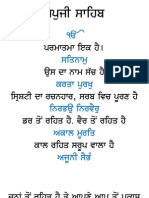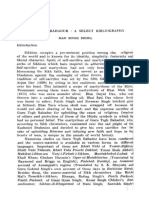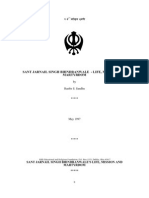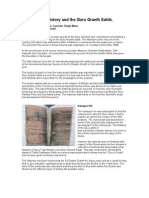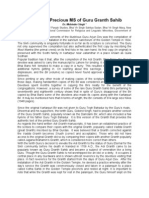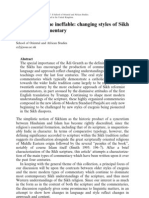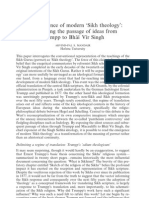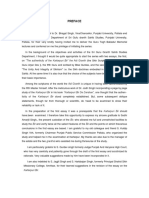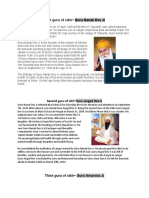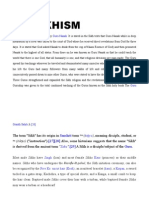Janamsakhi
Janamsakhi
Uploaded by
Manjot Singh SinghCopyright:
Available Formats
Janamsakhi
Janamsakhi
Uploaded by
Manjot Singh SinghOriginal Title
Copyright
Available Formats
Share this document
Did you find this document useful?
Is this content inappropriate?
Copyright:
Available Formats
Janamsakhi
Janamsakhi
Uploaded by
Manjot Singh SinghCopyright:
Available Formats
Janamsakhis, literally Birth Stories, are writings which profess to be biograhies of the first Guru, Guru Nanak Dev
ji. These compositions have been written at various stages after the demise of the first Guru. They all record miraculous acts and supernatural conversations. Many of them contradict each other on material points and some have obviously been touched up to advance the claims of one or the other branches of the Guru's family, or to exaggerate the roles of certain disciples. Macauliffe compares the manipulation of janamsakhs to the way gospels were also manipulated in the early Christian Church: "Vast numbers of spurious writings bearing the names of apostles and their followers, and claiming more or less direct apostolic authority, were in circulation in the early Church - Gospels according to Peter, to Thomas, to James, to Judas, according to the Apostles, or according to the Twelve, to Barnabas, to Matthias, to Nicodemus, & co.; and ecclesiastical writers bear abundant testimony to the early and rapid growth of apocryphal literature. - Supernatural Religion, vol.i, p.292. It may be incidentally mentioned that it was the Gospel according to Barnabas which Muhammad used in the composition of the Quran." The falsification of old or the composition of new Janamsakhis were the result of three great schisms of the Sikh religion: The Udasis, the Minasand the Handalis. A video in Punjabi from Sikh Gurbani Program Raghbir Singh Samagh with Gurcharan
Singh Brar discussion of the Bhai Bala Janaamsakhi Though from the point of view of a historian the janamsakhis may be inadequate, they cannot be wholly discarded because they were based on legend and tradition which had grown up around the Guru in the years following his demise, and furnish useful material to augment the bare but proved facts of his life. The main janamsakhis which scholars over the years have referred to are as follows:
Bhai Bala Janamsakhi
This is probably the most popular and well known Janamsakhi, in that most Sikhs and their Janamsakhi knowledge comes from this document. This work claims to be a contemporarry account written by one Bala Sandhu in the Sambat year 1592 at the instance of the second Guru, Guru Angad. According to the author, he was a close companion of Guru Nanak and accompanied him on many of his travels. There are good reasons to doubt this contention:
Guru Angad, who is said to have commissioned the work and was also a close
companion of the Guru in his later years, was, according to Bala's own admission, ignorant of the existence of Bala. Bhai Gurdas, who has listed all Guru Nanak's prominent disciples whose names were
handed down, does not mention the name of Bala Sandhu. (This may be an oversight, for he does not mention Rai Bular either.) Bhai Mani Singh's Bhagat Ratanwali, which contains essentialy the same list as that by
Bhai Gurdas, but with more detail, also does not mention Bala Sandhu. It is only in the heretic janamsakhis of the Minas that we find first mention of Bhai Bala. The language used in this janamsakhi was not spoken at the time of Guru Nanak or Guru
Angad, but was developed at least a hundred years later. Some of the hymns ascribed to Nanak are not his but those of the second and fifth
Gurus. At several places expressions which gained currency only during the lifetime of the last
Guru, Guru Gobind Singh (1666-1708), are used e.g Waheguru ji ki Fateh. Bala's janamsakhi is certainly not a contemporary account; at best it was written in the early part of the 18tyh Century. This janamsakhi has had an immense influence over determining what is generally accepted as the authoritative account of Guru Nanak Dev Jis life. Throughout the nineteenth century the authority of the Bala version was unchallenged. An important work based on the Bahi Bala janam-sakhi is Santokh Singhs Gur Nanak Purkash commonly known as Nanak Parkash. Its lengthy sequel, Suraj Parkash carries the acount up to the tenth Guru and contains a higher proportion of historical fact, this was completed in 1844. In the first journey or udasi Guru Nanak Dev Ji left Sultanpur towards eastern India and included, in the following sequence : Panipat (Sheikh Sharaf) Delhi (Sultan Ibrahim Lodi) Hardwar Allahbad Banaras Nanakmata Kauru, Kamrup in Assam (Nur Shah) Talvandi (twelve years after leaving Sultanpur) Pak Pattan (Sheikh Ibrahim) Goindval Lahore Kartarpur. The Second udasi was to the south of India with companion Bhai Mardana. Delhi Ayodhya Jagannath Puri Rameswaram Sri Lanka Vindhya mountains Narabad River Ujjain Saurashtra Mathura The third udasi was to the north : Kashmir Mount Sumeru Achal The fourth udasi was to the west. Afghanistan Persia Mecca Madina Baghdad
Vilayat Vali Janamsakhi
In the year 1883 a copy of a janamasakhi was dispatched by the India Office Library in London for the use of Dr.Trumpp and the Sikh scholars assisting him. (It had been givn to the library by an Englishman called Colebrook; it came to be known as the Vilayat Vali or the foreign janamsakhi.) This janamsakhi was the basis of the accounts written by Trumpp, Macauliffe, and most Sikh scholars. It is said to have been written in 1588 AD by one Sewa Das.
Hafizabad Vali Janamsakhi
A renowned Sikh scholar, Gurmukh Singh of the Oriental College, Lahore, found another janamsakhi at Hafizabad which was very similar to that found by Colebrook. Gurmukh Singh who was collaborating with Mr.Macauliffe in his research on Sikh religion, made it available to the Englishman, who had it published in November 1885. This biography agrees entirely with the India Office janamsakhi.
Bhai Mani Singhs Janam-sakhi
or Gyan-ratanavali. The fourth and eveidently the latest is the Gyan-ratanavali attributed to Bhai Mani Singh who wrote it with the express intention of correcting heretical accounts of Guru Nanak Dev Ji. Bhai Mani Singh was a Sikh of Guru Gobind Singh Ji. He was approached by some Sikhs with a request that he should prepare an authentic account of Guru Nanak Dev Jis life. This they assured him was essential as the Minas were circulating objectionable things in their version. Bhai Mani Singh referred them to the Var of Bhai Gurdas Ji, but this, they maintained was to brief and a longer more fuller account was needed. Bhai Mani Singh writes : Just as swimmers fix reeds in the river so that those who do not know the way may also cross, so I shall take Bhai Gurdass var as my basis and in accordance with it, and with the accounts that I have heard at the court of the tenth Master, I shall relate to you whatever commentary issues from my humble mind. At the end of the Janam-sakhi there is an epilogue in which it is stated that the completed work was taken to Guru Gobind Singh Ji for his seal of approval. Guru Sahib Ji duly signed it and commended it as a means of acquiring knowledge of Sikh belief.
You might also like
- Japji Sahib Steek Brief - GurmukhiDocument81 pagesJapji Sahib Steek Brief - GurmukhiHarkirat Singh95% (39)
- The Text and Meaning of The Adi Granth - Pashaura Singh Banned ThesisDocument261 pagesThe Text and Meaning of The Adi Granth - Pashaura Singh Banned Thesisghantasingh9000100% (1)
- Drinking From Love's Cup: Surrender and Sacrifice in The Vārs of Bhai Gurdas BhallaDocument297 pagesDrinking From Love's Cup: Surrender and Sacrifice in The Vārs of Bhai Gurdas BhallaUday SinghNo ratings yet
- Sri Dasam Granth Sahib Questions and AnswersDocument9 pagesSri Dasam Granth Sahib Questions and AnswersGurinder Singh Mann100% (3)
- The Punjab News in The Akhbar-I-Darbar-I-Mualla - Dr. Ganda SinghDocument6 pagesThe Punjab News in The Akhbar-I-Darbar-I-Mualla - Dr. Ganda SinghSikhDigitalLibraryNo ratings yet
- Hari Singh Nalwa by Gurbachan Singh Nayyar PDFDocument95 pagesHari Singh Nalwa by Gurbachan Singh Nayyar PDFHardev SinghNo ratings yet
- Concerns With Sojhi Currliculum Developed by SikhRI and Harinder SinghDocument7 pagesConcerns With Sojhi Currliculum Developed by SikhRI and Harinder Singhapi-19809655No ratings yet
- Koer Singh and His History of The Tenth King1Document15 pagesKoer Singh and His History of The Tenth King1prabhjotsinghnsr0% (1)
- Episodes From Lives of The Gurus - English Translation of Sewa Das's ParchianDocument67 pagesEpisodes From Lives of The Gurus - English Translation of Sewa Das's Parchiandalsingh101No ratings yet
- (Dimensions of Asian Spirituality) Doris R. Jakobsh - Sikhism-University of Hawai'i Press (2012)Document161 pages(Dimensions of Asian Spirituality) Doris R. Jakobsh - Sikhism-University of Hawai'i Press (2012)Tatuka DolidzeNo ratings yet
- Descriptions of The Dasam Granth From The Sketch of The Sikhs in View of Sikh HistoryDocument12 pagesDescriptions of The Dasam Granth From The Sketch of The Sikhs in View of Sikh Historydasamgranth.com100% (1)
- Assessmen of Report of Sodhak Committeee - Gurtej SinghDocument4 pagesAssessmen of Report of Sodhak Committeee - Gurtej Singhbanda singhNo ratings yet
- Bhangu Panth Prakash - MannDocument44 pagesBhangu Panth Prakash - MannVilokNo ratings yet
- Kavi DurbarDocument6 pagesKavi DurbarJagjit SinghNo ratings yet
- Exegesis of Sri Guru Granth Sahib in Singh Sabha School: A Critical StudyDocument10 pagesExegesis of Sri Guru Granth Sahib in Singh Sabha School: A Critical StudyHEERA SINGH DARDNo ratings yet
- Guru Tegh Bahadur A Select Bibliography - Man Singh DeoraDocument17 pagesGuru Tegh Bahadur A Select Bibliography - Man Singh DeoraSikhDigitalLibraryNo ratings yet
- Christopher Shackle, Rana Surat Singh by Bhai Vir SinghDocument27 pagesChristopher Shackle, Rana Surat Singh by Bhai Vir SinghSikh TextsNo ratings yet
- JPS Uberoi - The Body of Christ and The Origin of ModernityDocument53 pagesJPS Uberoi - The Body of Christ and The Origin of ModernityPaul BourbonNo ratings yet
- Japji - EnglishDocument93 pagesJapji - EnglishholaNo ratings yet
- Sikh Faith of The Khalsa (English)Document92 pagesSikh Faith of The Khalsa (English)Singh1430No ratings yet
- Sikhs and Sikhism: A View With A Bias: I.J. SinghDocument184 pagesSikhs and Sikhism: A View With A Bias: I.J. SinghUday SinghNo ratings yet
- Bhagat Lakshman Singh Autobiography - Dr. Ganda Singh (Edited and Annotated)Document358 pagesBhagat Lakshman Singh Autobiography - Dr. Ganda Singh (Edited and Annotated)SikhDigitalLibraryNo ratings yet
- Sant Jarnail Singh Bhindranwale - Life, Mission, and MartyrdomDocument62 pagesSant Jarnail Singh Bhindranwale - Life, Mission, and MartyrdomAmandeep Singh AujlaNo ratings yet
- Travels in Kashmir and The Panjab - Baron Charles HugelDocument448 pagesTravels in Kashmir and The Panjab - Baron Charles HugelSikhDigitalLibrary100% (1)
- Guru Granth Sahib As The Only Sikh CanonDocument13 pagesGuru Granth Sahib As The Only Sikh CanonhardeepNo ratings yet
- Debunking SiyarDocument12 pagesDebunking SiyarTaranjeet SinghNo ratings yet
- Manuscripts, History and The Guru Granth SahibDocument2 pagesManuscripts, History and The Guru Granth SahibGurinder Singh MannNo ratings yet
- Preserving Manuscripts of Guru GranthDocument4 pagesPreserving Manuscripts of Guru GranthMark McDonald100% (1)
- Repackaging The Ineffable Changing Styles of Sikh Scriptural Commentary - Christopher ShackleDocument23 pagesRepackaging The Ineffable Changing Styles of Sikh Scriptural Commentary - Christopher Shackledalsingh101No ratings yet
- Dasam Granth Authenticity-Harinder Singh MehboobDocument17 pagesDasam Granth Authenticity-Harinder Singh MehboobGurpreet SinghNo ratings yet
- Guru Ram Das JiDocument13 pagesGuru Ram Das JiRajNo ratings yet
- The Emergence of Modern 'Sikh Theology'Document23 pagesThe Emergence of Modern 'Sikh Theology'yakarjNo ratings yet
- History of Binod Singh Sikh WorriorDocument7 pagesHistory of Binod Singh Sikh WorriorNihaal Singh jagraonNo ratings yet
- Final Proposal As AssignmentDocument10 pagesFinal Proposal As Assignmentc_masudNo ratings yet
- Bha Gavatapura N A Brill 2019 PDFDocument27 pagesBha Gavatapura N A Brill 2019 PDFIraniJunior100% (1)
- 1858 The History of The Indian Mutiny Vol 1 by Ball SDocument213 pages1858 The History of The Indian Mutiny Vol 1 by Ball SSoumaya KarmakarNo ratings yet
- Japanese Novels in The Edo PeriodDocument17 pagesJapanese Novels in The Edo PeriodSrujana KarnatiNo ratings yet
- KhalistanDocument17 pagesKhalistanCristiano JuniorNo ratings yet
- BACHITRA NATAK by DR Jodh SinghDocument3 pagesBACHITRA NATAK by DR Jodh Singhdasamgranth.comNo ratings yet
- Oral Literature of Kashmiri LanguageDocument70 pagesOral Literature of Kashmiri LanguageabujeNo ratings yet
- Corpusinscription - BharhutDocument350 pagesCorpusinscription - BharhutTrina MukhopadhyayNo ratings yet
- Sikh Rehats: Rihxi Rhy Soei Isk Myrw) Euh Twkuru My Aus KW Cyrw)Document6 pagesSikh Rehats: Rihxi Rhy Soei Isk Myrw) Euh Twkuru My Aus KW Cyrw)Bhai Kanhaiya Charitable TrustNo ratings yet
- After The Tenth Master PDFDocument137 pagesAfter The Tenth Master PDFsNo ratings yet
- Vedant - Singh Sabha MovementDocument5 pagesVedant - Singh Sabha Movementmina579623No ratings yet
- History of RavidassiaDocument34 pagesHistory of Ravidassia123chamarNo ratings yet
- Bara MahDocument36 pagesBara MahHarpreet Singh100% (2)
- Guru Nanak's Travel To The Middle EastDocument49 pagesGuru Nanak's Travel To The Middle EastsarblohwarriorNo ratings yet
- Review of Design and Rhetoric in A Sanskrit Court Epic: The "Kirātārjunīya" of Bhāravi, by Indira Viswanathan Peterson.Document5 pagesReview of Design and Rhetoric in A Sanskrit Court Epic: The "Kirātārjunīya" of Bhāravi, by Indira Viswanathan Peterson.Ben WilliamsNo ratings yet
- Narrating A Nation Author (S) : Meenakshi Mukherjee Source: Indian Literature, July-August, 1992, Vol. 35, No. 4 (150) (July-August, 1992), Pp. 138-149 Published By: Sahitya AkademiDocument13 pagesNarrating A Nation Author (S) : Meenakshi Mukherjee Source: Indian Literature, July-August, 1992, Vol. 35, No. 4 (150) (July-August, 1992), Pp. 138-149 Published By: Sahitya AkademiCherNo ratings yet
- BedtimeStories GuruNanakDevJiDocument86 pagesBedtimeStories GuruNanakDevJiHarman S1nghkNo ratings yet
- Exile PoetryDocument2 pagesExile PoetryMuntaha FawadNo ratings yet
- Empire, Orientalism, and Native Informants: The Scholarly Endeavours of Sir Attar Singh Bhadour Harjot OberoiDocument20 pagesEmpire, Orientalism, and Native Informants: The Scholarly Endeavours of Sir Attar Singh Bhadour Harjot OberoiDr. Kamalroop SinghNo ratings yet
- Sikhism Based On GurbaniDocument184 pagesSikhism Based On GurbaniparkashkaurNo ratings yet
- The Scattered Court: Hindustani Music in Colonial BengalFrom EverandThe Scattered Court: Hindustani Music in Colonial BengalNo ratings yet
- Too Brave to Dream: Encounters with Modern ArtFrom EverandToo Brave to Dream: Encounters with Modern ArtRating: 3 out of 5 stars3/5 (1)
- Concepts SikhismDocument28 pagesConcepts Sikhismmusic2850No ratings yet
- History of Compilation of Guru Granth SahibDocument6 pagesHistory of Compilation of Guru Granth Sahibgoraya15No ratings yet
- Janam-Sakhis: The Fable-Ous Cultural HeritageDocument1 pageJanam-Sakhis: The Fable-Ous Cultural HeritageParamjit Singh KhalsaNo ratings yet
- A Note On Sri Dasam Granth Sahib.Document36 pagesA Note On Sri Dasam Granth Sahib.dasamgranth.comNo ratings yet
- Baba Budha Ji - SHort Life HistoryDocument2 pagesBaba Budha Ji - SHort Life HistoryPuneet Kanwar Singh Kundi100% (2)
- SikhismDocument24 pagesSikhismabbeymel.l.lauretaNo ratings yet
- Punjab GK MCQDocument3 pagesPunjab GK MCQJagmeet SinghNo ratings yet
- Puratan Sri Guru Granth Sahib Da Saroop Dated 1714AD English PDFDocument75 pagesPuratan Sri Guru Granth Sahib Da Saroop Dated 1714AD English PDFTripatdeep SinghNo ratings yet
- Sri Chand DebunkDocument3 pagesSri Chand Debunktaranjeet1013No ratings yet
- List of Schools For Inspire Award MansaDocument60 pagesList of Schools For Inspire Award MansaJashan SekhonNo ratings yet
- Bala Janamsakhi DebunkDocument9 pagesBala Janamsakhi DebunkdinkukhichiNo ratings yet
- JapjiDocument23 pagesJapjiJennifer JacominiNo ratings yet
- ArdaasDocument5 pagesArdaasJeswinder SinghNo ratings yet
- Gagan Mein Thaal Aarti LyricsDocument3 pagesGagan Mein Thaal Aarti Lyricssupersrikanth5304100% (2)
- 65-67 - GK Bytes PunjabDocument3 pages65-67 - GK Bytes PunjabManoj PrabhakarNo ratings yet
- First Guru of Sikh : Guru Nanak Dev JiDocument4 pagesFirst Guru of Sikh : Guru Nanak Dev Jiramanpreet kaurNo ratings yet
- SikhNet Calendar 2023 GiftDocument13 pagesSikhNet Calendar 2023 Giftkahlon.manpreet556No ratings yet
- Schools Chandigarh: Cambridge SchoolDocument13 pagesSchools Chandigarh: Cambridge Schoolsavita17julyNo ratings yet
- Guruship Table - SikhiWiki, Free Sikh Encyclopedia.Document1 pageGuruship Table - SikhiWiki, Free Sikh Encyclopedia.Gurpreet Reetu (guri)No ratings yet
- 10 Sikh GurusDocument6 pages10 Sikh Gurussinghsinghmalhi555No ratings yet
- Nanaksar Events Eng 2020Document1 pageNanaksar Events Eng 2020Des MoiynsNo ratings yet
- Glossary of GurSikh - 11th Vaar of Bhai Gurdaas-1 PDFDocument45 pagesGlossary of GurSikh - 11th Vaar of Bhai Gurdaas-1 PDFArash Sharma100% (1)
- Naam Ras Table Calendar - 2024Document13 pagesNaam Ras Table Calendar - 2024Rishabh Previn Singh DhillonNo ratings yet
- 宗教經典三六O 第八冊-錫克教 Sikh Faith 360Document432 pages宗教經典三六O 第八冊-錫克教 Sikh Faith 360leo_hindartoNo ratings yet
- History of Sikhism - the 10 Gurus MindmapDocument1 pageHistory of Sikhism - the 10 Gurus Mindmapkkrish101No ratings yet
- Sikhism: Guru NanakDocument6 pagesSikhism: Guru NanakSanjif SaravananNo ratings yet
- History of Ten Sikh Gurus PDFDocument5 pagesHistory of Ten Sikh Gurus PDFSudhir KumarNo ratings yet
- Hymn of The Sikh GurusDocument275 pagesHymn of The Sikh GurusUday SinghNo ratings yet
- Centre List Session May. - 2016 (Supplementary Exam) : Sr. NoDocument74 pagesCentre List Session May. - 2016 (Supplementary Exam) : Sr. Noarbaz khanNo ratings yet
- Guru Granth Sahib Phonetic TranscriptionDocument1,510 pagesGuru Granth Sahib Phonetic TranscriptionUday SinghNo ratings yet
- Sikh Calendar 2021Document1 pageSikh Calendar 2021shahzadroy79630No ratings yet
- Contact Details of Colleges Dec 2013 (Non-AICTE)Document8 pagesContact Details of Colleges Dec 2013 (Non-AICTE)hareshNo ratings yet
